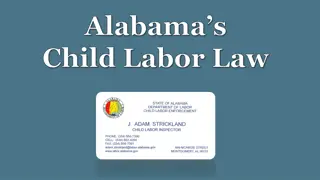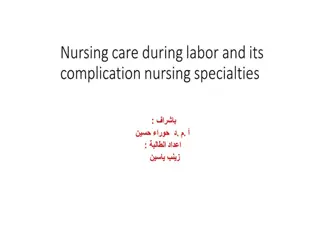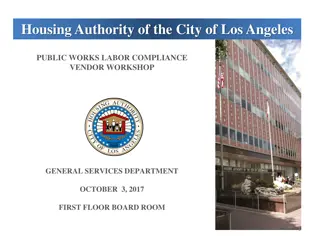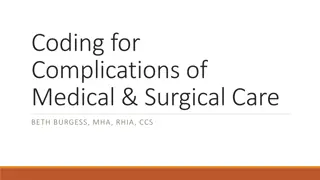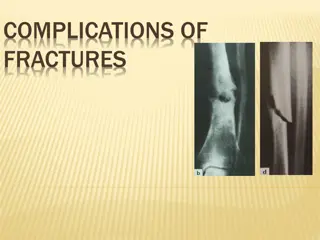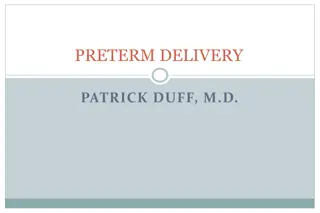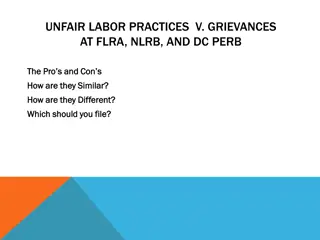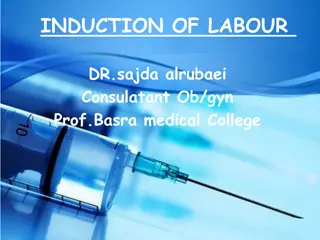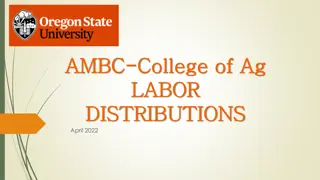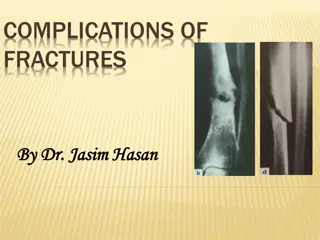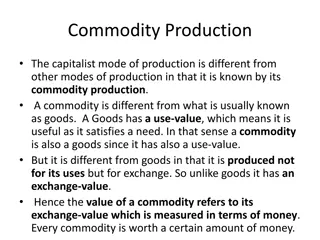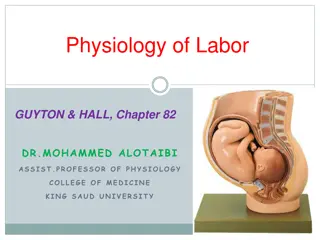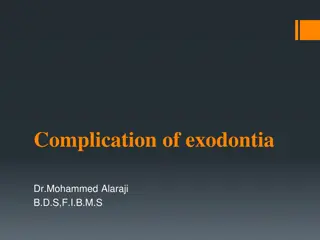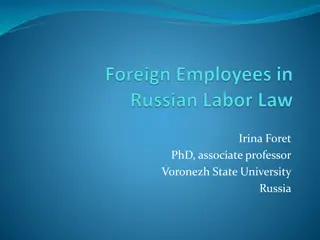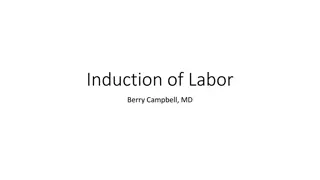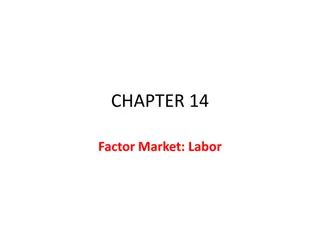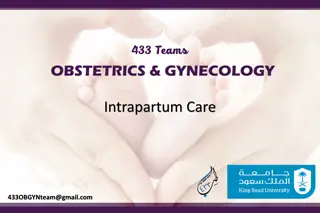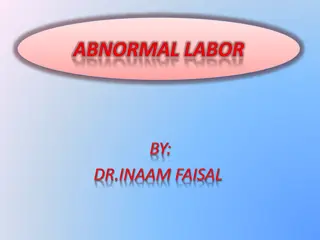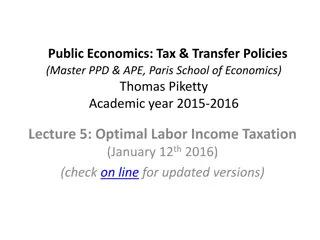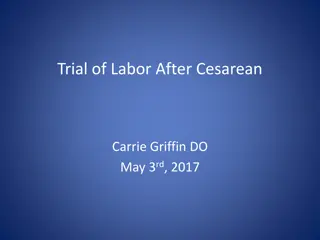Debates on the Mode of Production in Indian Agriculture
Dr. S. Mehdi Abbas Zaidi and Ms. Bushra Fatima discuss the elements of production in Indian agriculture, including the objects of labor, instruments of labor, and the role of labor itself. They explain how these components interact to form the productive power of labor and shape the relations of pro
1 views • 19 slides
Guidelines for Induction of Labor in Family Medicine Forum 2023
The new SOGC Induction of Labor Guidelines 2023 were introduced at the Family Medicine Forum by Dr. Hannah Shenker and Dr. Helen Mavromichalis from McGill University. The presentation discussed various scenarios for inducing labor and highlighted key recommendations, including the importance of shar
0 views • 41 slides
Employment and Labor Law in Russia: Overview and Legal Rights for Foreigners
Irina Foret, PhD, an associate professor at Voronezh State University, provides valuable insights into the general issues surrounding employment and labor law in Russia, with a focus on the legal status of foreigners, work permits, and protection of labor rights. The Russian Federation extends right
2 views • 27 slides
Alabama Child Labor Law Guidelines
Alabama's Child Labor Law establishes regulations concerning the minimum age to work, exemptions for certain types of work like lemonade stands and agriculture, requirements for Child Labor Certificates, eligibility criteria for minors aged 14 and 15, the necessity of displaying labor law posters, r
1 views • 28 slides
Understanding Common Labor Complications and Management Options
Labor and birth processes are typically straightforward, but complications can arise, such as failure to progress, fetal distress, excessive bleeding, malposition, prolapsed umbilical cord, cephalopelvic disproportion, and uterine rupture. Management strategies include rupturing membranes, pain reli
1 views • 24 slides
Public Works Labor Compliance Vendor Workshop by Housing Authority of the City of Los Angeles
The Housing Authority of the City of Los Angeles conducted a workshop to assist contractors in understanding their Public Works labor compliance responsibilities. The workshop covered topics such as contractor responsibilities, registration with the state under SB854, federal and state labor laws, a
1 views • 26 slides
Guidelines for Coding Complications of Medical & Surgical Care
Proper documentation and coding of complications of medical and surgical care are essential for accurate classification and billing. Assigning codes based on the provider's documentation of the relationship between the condition and care is crucial. Complications must be clearly documented with a ca
1 views • 55 slides
Complications of Fractures: Types and Consequences
Fractures can lead to a variety of complications, both locally and generally. General complications include shock, embolisms, crush syndrome, and more. Local complications can involve visceral, vascular, nerve injuries, compartment syndrome, infections, and more. Late complications may result in del
0 views • 29 slides
Overview of Labor Law and Union Formation Process
Labor law governs the structure and operations of private labor relations in the United States. The National Labor Relations Act (NLRA) establishes the National Labor Relations Board (NLRB) to handle unfair labor practices in the private sector. The process of forming a union involves reaching out t
0 views • 11 slides
Economics of Labor Markets: Factors of Production and Labor Demand
The Economics of Labor Markets explores the markets for factors of production such as labor, land, and capital. Demand for these factors is derived from firms' decisions to produce goods. The labor market, governed by supply and demand forces, exhibits diminishing marginal product of labor due to fi
0 views • 41 slides
Tackling Child Labor in Uganda's Coffee Sector: A Project Approach
The "Child Education Project Uganda" led by Rashida Nakabuga aims to address the root causes of child labor in Uganda, particularly in the coffee sector. With a focus on poverty, gender inequality, and inadequate education, the project adopts a risk-based due diligence approach at the farm level to
0 views • 17 slides
Understanding Preterm Delivery: Causes, Complications, and Evaluation
Preterm delivery, defined as labor prior to 37 weeks of gestation, affects approximately 12% of pregnancies worldwide, with almost 30% of these deliveries occurring before 34 weeks. The etiology of preterm birth can vary from maternal factors such as PROM to fetal anomalies and multiple gestations.
0 views • 25 slides
Understanding Hyperemesis Gravidarum: Symptoms, Complications, and Management
Hyperemesis gravidarum is a severe condition in pregnancy characterized by intractable nausea and vomiting, resulting in fluid and electrolyte imbalances, nutritional disturbances, and physical and psychological debilitation. The exact cause is unknown, but factors like hormonal changes, genetics, a
0 views • 22 slides
Understanding Cesarean Section and Preterm Labor Risks
Cesarean section (C/S) is a delivery method for various fetal and maternal indications, while preterm labor poses risks like twin pregnancy, uterine abnormalities, and infections. Complications of C-sections and signs of preterm labor are discussed, highlighting the importance of early recognition a
0 views • 9 slides
Understanding Unfair Labor Practices vs. Grievances at FLRA, NLRB, and DC PERB
Unfair labor practices (ULPs) are violations of federal labor laws, while grievances involve disputes between labor organizations and agencies. Different reviewing authorities handle these matters: FLRA for federal, NLRB for private sector, and DC PERB for DC government agencies. Each organization h
0 views • 47 slides
Overview of Induction of Labour for Obstetric Practice
Induction of labor is the artificial initiation of the labor process before it begins naturally. This procedure is performed in cases such as premature rupture of membranes, prolonged pregnancy, preterm premature rupture of membranes, pre-eclampsia, and maternal medical conditions like diabetes or c
1 views • 30 slides
Labor Clauses with Institutionalized Cooperation Measures in FTAs: A Win-Win Outcome in North-South Relations
Labor provisions in Free Trade Agreements (FTAs) have been a subject of debate, with key discussions focusing on whether they benefit workers, prevent protectionism, and promote economic development. Research suggests that including labor clauses with institutionalized cooperation measures can have
0 views • 25 slides
Labor-Management Forum Reporting Tool Analysis
The Problem Resolution Subcommittee's presentation to the National Council on Federal Labor-Management Relations on January 15, 2014, highlighted the development and outcomes of the Labor-Management Forum (LMF) Reporting Tool. The tool aimed to address specific problems, identify barriers, and showc
0 views • 20 slides
Costing and Variance Analysis in Manufacturing Processes
The content discusses various scenarios related to costing and variance analysis in manufacturing processes. It addresses topics such as direct materials usage variance, direct labor mix and yield variances, total direct labor efficiency variance, and standard costing system variances. The examples
0 views • 8 slides
Labor Distribution Form and Process Overview
Understanding the labor distribution form process is crucial for managing changes in job duties and effort allocation. The OSRAA form is utilized for all labor distributions, ensuring accountability and clarity in budget allocations. Proper documentation and justification are key in facilitating smo
0 views • 48 slides
Complications of Fractures: Types and Risks
Complications of fractures can be classified as general, local early, and late complications. General complications include shock, embolisms, and fever while local complications involve injuries to nearby tissues and infections. Early local complications can lead to visceral, vascular, nerve injurie
0 views • 29 slides
Complications of Fractures and Their Management by Dr. Jasim Hasan
This detailed presentation by Dr. Jasim Hasan covers the complications of fractures, including general and local complications, early and late complications, and specific issues such as shock, vascular injuries, nerve damage, and more. The information highlights the importance of recognizing and add
0 views • 29 slides
Understanding Commodity Production and Labor in Capitalist Mode
The capitalist mode of production is characterized by commodity production, where goods are produced not for their use but for exchange. The value of a commodity is determined by its exchange value, measured in money, which is influenced by the quantity of labor involved in its production. Labor, be
0 views • 8 slides
Complications One Year After Mid-Urethral Slings in Sweden
This study aims to provide a quantitative analysis of patient-reported complications one year after mid-urethral slings in Sweden. The GynOp register covers all Swedish surgeries with a high coverage and patient response rate. The study, led by Stefan Zacharias and Eva Uustal, looks into complicatio
0 views • 17 slides
The Pullman Strike of 1894: Eugene Debs and Labor Unrest
The Pullman Strike of 1894 was a pivotal event in American labor history, led by Eugene Debs and the American Railway Union against the Pullman Company's unfair labor practices. Workers protested wage cuts and living conditions, sparking a nationwide strike that disrupted rail traffic. Despite facin
0 views • 18 slides
Study on Return Migration and Labor Market Outcomes in Romania and Bulgaria
This study examines the impact of return migration on the labor market outcomes of Bulgarian and Romanian migrants, exploring factors influencing their decisions to return, such as labor market structure, monetary incentives, and family motives. The literature review indicates varying skill distribu
0 views • 15 slides
Understanding the Physiology of Labor in Pregnancy
Labor, also known as parturition, is the process of uterine contractions leading to the expulsion of the fetus. Various hormonal changes, including increased estrogen levels, play a crucial role in triggering and regulating labor. The progression from a quiescent uterus to active contractions involv
0 views • 29 slides
Comprehensive Guide to the Management of Normal Labor by Professor Muhsin-AL-Sabbak
Understanding the management of normal labor is crucial for healthcare professionals. This comprehensive guide covers the definition of normal vaginal delivery, diagnosis of labor, stages of labor, phases of labor, and the use of tools like partogram and cardiotocography to monitor progress. Profess
0 views • 9 slides
Physiology of Labor: Onset and Key Hormonal Changes
Labor, or parturition, involves uterine contractions leading to the fetus's expulsion. Factors triggering labor include hormonal changes like increased estrogen and decreased progesterone, which stimulate uterine muscle activity. Telocytes play a role in spontaneous uterine activity, while oxytocin
0 views • 36 slides
Common Complications of Exodontia in Dental Practice
Undesirable situations can arise during dental exodontia, including perioperative and postoperative complications. Perioperative complications may include crown fractures, soft tissue injuries, and failure to obtain anesthesia, while postoperative complications can involve trismus, hematoma, and wou
0 views • 48 slides
Migration Policies and Labor Laws in Russia: A Comprehensive Overview
Irina Foret, PhD, an associate professor at Voronezh State University, delves into the legal status of foreigners in Russia, including work visas, labor rights violations, and legal remedies. Key aspects such as Article 62 of the Constitution and Article 11 of the Labor Code are discussed, highlight
0 views • 30 slides
Impacts of Labor Productivity by Age and Changes in Age Structure on Labor Productivity in Vietnam
This research focuses on quantifying the impact of labor productivity by age on the overall economy's labor productivity in Vietnam. Utilizing analytical methods like the Cobb-Douglas production function and Shift-Share Analysis, the study aims to understand how changes in age structure and labor sh
0 views • 26 slides
Induction of Labor: Methods and Considerations
Induction of labor is done to achieve vaginal delivery before spontaneous onset, usually at 39 weeks or when medically necessary. Risks include failed induction, cesarean section, uterine rupture, prolonged labor, and infections. Cervical ripening methods help prepare the cervix for labor. The Bisho
0 views • 18 slides
Understanding Competitive Factor Market in Labor Economics
A competitive factor market involves a large number of sellers and buyers of a factor of production, like labor. With no single entity influencing prices, each acts as a price taker. The demand for factors depends on firms' output levels and input costs, leading to derived demands. Profitability of
0 views • 43 slides
Understanding Labor Productivity Growth in Europe: Insights from Productivity Project Conference
Divergent experiences in labor productivity growth between the US and Europe have sparked interest in analyzing factors affecting productivity. The Productivity Project Conference in January 2015 delved into macro and micro-level determinants of labor productivity, focusing on Total Factor Productiv
1 views • 27 slides
Department of Employment and Labour: Vision, Mandate, and Objectives
The Department of Employment and Labour aims to regulate the labor market through policies focusing on economic efficiency, decent employment, labor standards, and social safety nets. The department's vision is to create a conducive labor market for investment, economic growth, employment, and decen
0 views • 35 slides
Understanding Labor and Delivery: An In-depth Guide
Labor and delivery involve several stages and assessments to ensure the well-being of both the mother and the baby. From recognizing the signs of true labor to understanding the stages of labor, pain management options, and interventions such as active management of the third stage, this comprehensi
0 views • 11 slides
Understanding Abnormal Labor and Prolonged Labor in Childbirth
Labor is considered abnormal when there is poor progress or signs of compromise in the fetus. Prolonged labor, lasting more than 18 hours, may result from various factors affecting cervical dilatation and descent of the presenting part. Causes include issues with power, passage, and passenger. Diagn
0 views • 20 slides
Optimal Labor Income Taxation: Main Theoretical Results and Intuitions
The optimal taxation of labor income involves a U-shaped pattern of marginal tax rates, with top rates influenced by income concentration and labor supply elasticities. Mirrlees' model analyzes optimal labor income taxes based on productivity and labor supply decisions, aiming to maximize social wel
0 views • 24 slides
Understanding Trial of Labor After Cesarean (TOLAC) for VBAC Success
Explore the historical evolution of Vaginal Birth After Cesarean (VBAC) and Trial of Labor After Cesarean (TOLAC), including counseling patients on risks and success rates, labor management, complications, and strategies to prevent the need for a TOL. Delve into key milestones from ACOG encouraging
0 views • 46 slides



